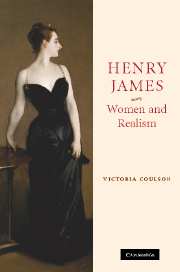Book contents
- Frontmatter
- Contents
- Acknowledgements
- List of abbreviations
- Introduction: ambivalent realism
- Chapter 1 Alice James and the portrait heroine
- Chapter 2 The actress and the orphan: Henry James's art of loss, 1882–1895
- Chapter 3 Teacups and love letters: Constance Fenimore Woolson and Henry James
- Chapter 4 Realism and interior design: Edith Wharton and Henry James
- Epilogue: 1892
- Notes
- Bibliography
- Index
Chapter 2 - The actress and the orphan: Henry James's art of loss, 1882–1895
Published online by Cambridge University Press: 22 September 2009
- Frontmatter
- Contents
- Acknowledgements
- List of abbreviations
- Introduction: ambivalent realism
- Chapter 1 Alice James and the portrait heroine
- Chapter 2 The actress and the orphan: Henry James's art of loss, 1882–1895
- Chapter 3 Teacups and love letters: Constance Fenimore Woolson and Henry James
- Chapter 4 Realism and interior design: Edith Wharton and Henry James
- Epilogue: 1892
- Notes
- Bibliography
- Index
Summary
We know of few similar phenomena … few such examples of rupture with a consecrated past.
(Henry James, ‘Mr. Tennyson's Drama’ (1875))DEATHS IN THE FAMILY
Mary Walsh James died suddenly in January 1882; Henry James, Sr died after only a few weeks’ illness in December of the same year. Family reactions to these deaths reveal the Jameses in some characteristic attitudes.
After Mary James's death, her devoted husband and daughter adapted themselves to her absence with such apparent equilibrium that Henry Jr was able to report, just five days later, that ‘My father and sister are wonderfully tranquil, and in their intense conviction that even the most exquisite sense of loss has a divine order in it are even almost happy!’ Indeed, Alice appeared rejuvenated. Henry – always her most sympathetic ally – noted in February that ‘after many years of ill health [Alice] has been better for the last few months than for a long time; she is able to look after my father and take care of his house’. Aunt Kate was rather less delicate about causality – not for her the decent predating of Henry's ‘last few months’: ‘her Mother's death seems to have brought new life to Alice’, she wrote to Bob's wife, Mary Holton James.
While Alice was revivified by Mary's death, Henry James, Sr seems rapidly to have lost his desire to live.
- Type
- Chapter
- Information
- Henry James, Women and Realism , pp. 60 - 95Publisher: Cambridge University PressPrint publication year: 2007



